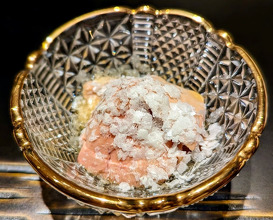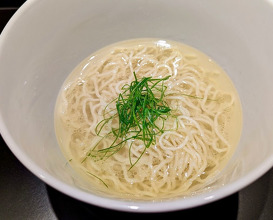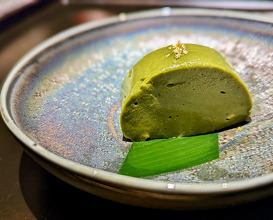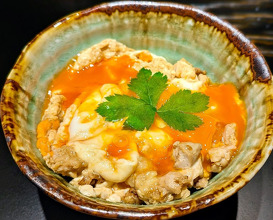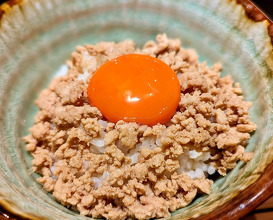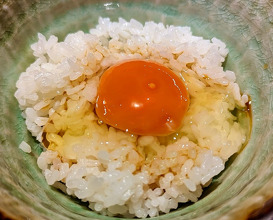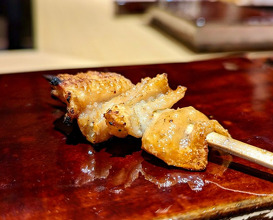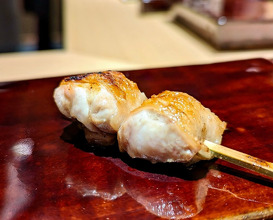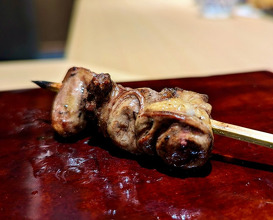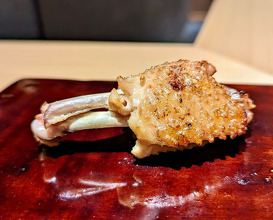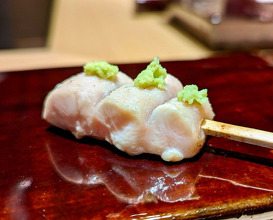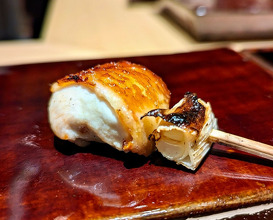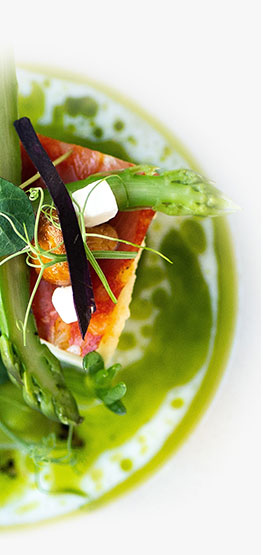.
༺ 𝓚𝓨𝓞𝓤𝓣𝓐𝓝𝓑𝓐 (𝓖𝓲𝓷𝔃𝓪) ║ 銀座やきとり 京丹羽 ༻
→҉ →҉ 𝘀𝘄𝗶𝗽𝗲 →҉ →҉ スワイプ →҉ →҉
⚡️ 生レバー
Liver
🍜 ラーメン
Ramen noodles
🍵 自家製の葛抹茶豆腐
Homemade kuzu green tea tofu
̴••̴•̴•̴ ̴••̴•̴•̴ ̴••̴•̴•̴ ̴••̴•̴•̴ ̴••̴•̴•̴ ̴••̴•̴•̴ ̴••̴•̴•̴ ̴••̴•̴
『世界一の鶏は高坂鶏』
多くの焼鳥ファンはその言葉に頷くだろう。高坂鶏が誕生して早20年。
2003年に「日本のブレス鶏」を作るべく、高坂鶏完成に向けての研究開発が発足しました。業務用に高坂鶏が初めて出荷されたのは2005年の春先でした。
ブレス鶏の肉質は脂肪が筋線維の奥深くまで浸透しており、「霜降り」と表現されます。薄い皮膚と繊細な肉質ゆえに、筋線維内の脂肪と水分をそのままの状態に保ちながら加熱しなければならないたね、ブレス鶏の美味しさを最大限に引き出すためには通常と異なる調理方法が必要で、それを更に困難にするのが高坂鶏です。高坂鶏の良さを引き出せる焼き師はごく僅か。高坂鶏のランクは細かく分かれてるのは周知の事実だが、飲食店の要望(予算)と高坂さんの目利き(その店をどれぐらい愛するか)でランクは決まります。最上ランクの高坂鶏を仕入れてるのは2店のみ。その同じランクの高坂鶏を使用するのが3店舗目となるこの「銀座焼き鳥 京丹羽」です。
髙坂鶏農園が2年以上かけて構想した焼鳥屋。関係者向けのオープン前試食会に髙坂さんやプロの方々と参加して参りました。
̴••̴•̴•̴ ̴••̴•̴•̴ ̴••̴•̴•̴ ̴••̴•̴•̴ ̴••̴•̴•̴ ̴••̴•̴•̴ ̴••̴•̴•̴ ̴••̴•̴
If you’re a yakitori fan, you’ve probably heard of Takasaka chicken. Just as there’s the “big three” wagyu in Japan, there’s a “big three” for chicken as well: Hinai Jidori (Akita), Nagoya Kouchin (Aichi), and Satsuma Jidori (Kagoshima). And just like with wagyu, the moniker is more a grandfathered recognition, as with the passage of time and advancement in technology, there are newer breeds of chicken (and wagyu) that eclipse the original leaders. (Did you know that there are actually FOUR brands that fall under the big three wagyu? Another long story for a post on a different day)
Takasaka chicken was born nearly 20 years ago when Takasaka-san was tasked to create the Japanese version of the popular “Poulet de Bresse”, the king of chicken from France. I’ll skip the English version of the details on why it’s now considered the best chicken in Japan but it’s the chicken that Kasahara (widely regarded as the top yakitori-ya in Japan) exclusively uses. The list of other restaurants that they provide to is quite impressive.
Two years in the making, Takasaka-san has finally opened his own yakitori restaurant in Ginza. Reservations are available on OMAKASE.
ご馳走様でした。
🐣𝕲𝖄𝕺𝕶𝖀𝕯𝕬𝕽𝕴🐣
ᴀɴᴅʀᴇᴡ | アンドリュー
🐣𝕲𝖄𝕺𝕶𝖀𝕯𝕬𝕽𝕴🐣
#高坂鶏農園公式アンバサダー
#髙坂鶏農園
#高坂鶏農園
#高坂鶏
#andrew_yakitori
#andrew_tokyo
#andrew_takasakadori
#やきとり
#焼鳥
#銀座グルメ
